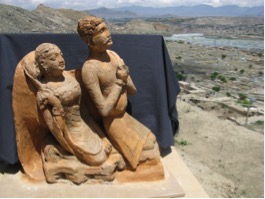
Zafar Paiman, Scientific Director of the excavations of the Afghan National Institute
Numerous sculptures, sometimes monumental, entirely made in red clay, or in yellow clay covered with red clay, and of a rather delicate work, come from various Buddhist monasteries of Kabul (Tepe Khazana, Tepe Maranjan, Khwaja Safa, Tepe Narenj), and region (Bazikhel), from Logar (Mes-e-Ainak, Kharwar), from Wardak (Al Ghata), as well as Ghazni (Tepe Sardar), Bamiyan (Kamard) Fondukistan and Hadda (Kafariya, Tepe Tepe Shotor). They testify to the importance of this material in the Buddhist art of the southern part of the Afghanistan.
The discovery of recent such sculptures, combined with that of coins and ceramics, were made at the monastic sites of Tepe Narenj and Khwaja Safa, between 2004 and 2013, and their comparison with the sculptures of the above-mentioned monasteries, in our opinion, confirm that all these sculptures belong to a late phase of Buddhism in Afghanistan, which was not before late 7th or early 8th century. Thus, this challenges the generally accepted opinion that attributed, until now, the sculptures using red clay to the 3rd or 4th centuries, or even to the 5th, 6th centuries.

